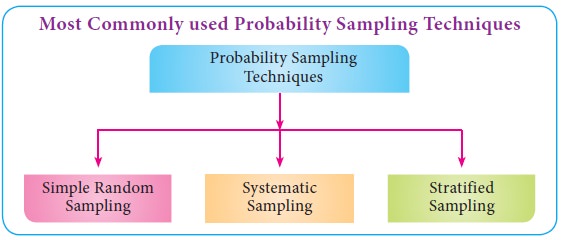Various Techniques, Merits, Limitations, Solved Example Problems, Applications - Simple random sampling | 11th Statistics : Chapter 2 : Collection of Data and Sampling Methods
Chapter: 11th Statistics : Chapter 2 : Collection of Data and Sampling Methods
Simple random sampling

Simple random sampling
This method selects a sample in such a way that each possible sample to have an equal probability of being selected or each item in the entire population to have an equal probability of being included in the sample. The following are the methods of selecting a simple random sample.
(1) Lottery Method
Suppose that we have to select a random sample of size n from a finite population of size N. First assign numbers 1 to N to all the N units of the population. Then write numbers 1 to N on different identical slips or cards so that a card is not distinguishable from another. They are folded and mixed up in a drum or a box or a container. A blindfold selection is made. The selected card may be replaced or may not be replaced before the next draw. The Required numbers of slips are selected for the desired sample size under any one of these methods forms a simple random sample. The selection of items thus depends on chance.
Simple random sampling without replacement (SRSWOR):
If the selected cards are not replaced before the next draw, such a sampling is called without replacement.
Simple random sampling with replacement (SRSWR):
If the selected cards are replaced before the next draw, such a sampling is called sampling with replacement
Remark:
If the population size is large, this method is cumbersome. The alternative method is using of table of random numbers.
(2) Table of Random numbers
The easiest way to select a sample randomly is to use random number tables. There are several tables of random numbers. Some of them are
· Kendall and Smith random number table.
· Tippet’s random number table.
· Fishers and Yates random number table.
Method of using Random Number table.
In a given finite population, the method of selecting a random sample from a random number table is given below:
The table contains different numbers consisting of 0, 1, 2,… ,9 and possesses the essential characteristics which ensures random sampling. A part of the table is given as Appendix. Referring to this page, selection of a random sample is explained by taking a finite population of size 100 units and selecting a sample of 10 units. The steps to be followed are listed as under.
· A list of all 100 units in the finite population is prepared and each unit is assigned a serial number ranging from 00 to 99.
· Any number in the table is chosen at random and it is the starting point for selecting the sampling units.
· From the starting point we can make a move on to the next number either vertically, horizontally or diagonally.
· Since our numbered population consists of two digits from 00 to 99 , we confine ourselves to reading only two digit numbers without omitting any number that comes forward.
· As we proceed, random numbers read from the table which are above 99 are ignored and those numbers which are less than are equal to 99 are recorded. This process is continued until we reach 10 such random numbers.
· If sampling without replacement scheme is followed, a random number once recorded appears again, the same is omitted and we move on to the next number.
· The 10 such selected random numbers are compared with the labeled (numbered) population units and the corresponding units are selected to get a simple random sample of size 10.
Example 2.1
Select a random sample of size 15 from the random number table from a finite population of size 220.
Step 1 : Assign serial numbers 00 to 219 to the 220 units of the population.
Step 2 : Since the maximum digit is 3, select a three digit as starting point. Let the starting point in the random number table is 066.(first two digits of the entry in the 11th row and 4th column).
Step 3 : Continue in the column downwards to select random numbers of size 15.
Step 4 : The numbers chosen to have SRS are 066, 147, 119, 194, 093, 180, 092, 127, 211, 087, 002, 214, 176, 063 and 176. If we get any random number greater than 219, then the multiple of 219 is to be subtracted from the selected number such that the resultant value is less than 219.
Illustration:
Assume that the random is 892. But here, the maximum value assigned for the population is 219 . Hence we select ’4’as the multiplier of 219. Then the random number correspond to 892 is 016. (See: 892 - 4 # 219 = 892 - 876 = 16 )
Case(1) : Under SRSWR: Here the random sample is 066, 147, 119, 194, 093, 180, 092, 127, 211, 087, 002, 214, 176, 063 and 176.
Case(2): Under SRSWOR: Here the random sample is 066, 147, 119, 194, 093, 180, 092, 127, 211, 087, 002, 214, 176, 063and 157.
Merits:
· It is more representative of the universe.
· It is free from personal bias and prejudices.
· The method is simple to use.
· It is to assess sampling error in the method.
Demerits:
· If the units are widely dispersed, the sample becomes unrepresentative.
· The method is not applicable when the units are heterogeneous in nature.
· Units selected may be too widely dispersed; thus, adherence to the whole sample may be difficult. Remark: Simple random sampling is more suitable when the population is homogeneous. If the population is heterogeneous we must go in for stratified random sampling.
Related Topics